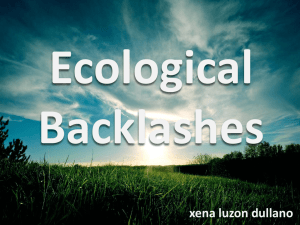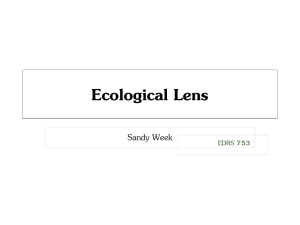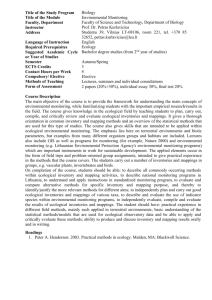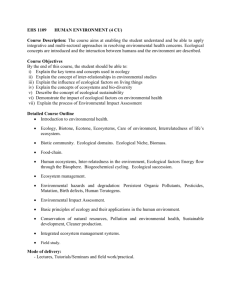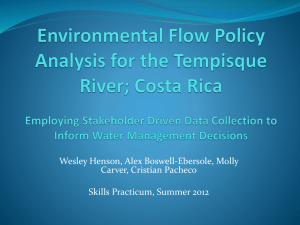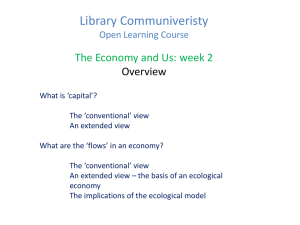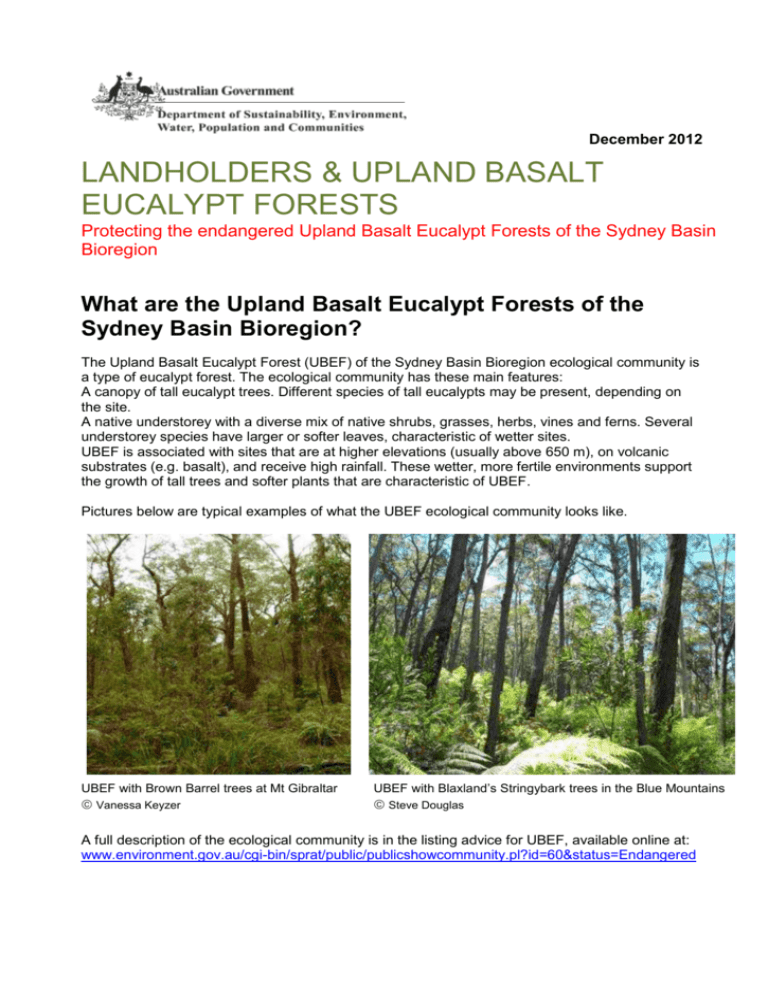
December 2012
LANDHOLDERS & UPLAND BASALT
EUCALYPT FORESTS
Protecting the endangered Upland Basalt Eucalypt Forests of the Sydney Basin
Bioregion
What are the Upland Basalt Eucalypt Forests of the
Sydney Basin Bioregion?
The Upland Basalt Eucalypt Forest (UBEF) of the Sydney Basin Bioregion ecological community is
a type of eucalypt forest. The ecological community has these main features:
A canopy of tall eucalypt trees. Different species of tall eucalypts may be present, depending on
the site.
A native understorey with a diverse mix of native shrubs, grasses, herbs, vines and ferns. Several
understorey species have larger or softer leaves, characteristic of wetter sites.
UBEF is associated with sites that are at higher elevations (usually above 650 m), on volcanic
substrates (e.g. basalt), and receive high rainfall. These wetter, more fertile environments support
the growth of tall trees and softer plants that are characteristic of UBEF.
Pictures below are typical examples of what the UBEF ecological community looks like.
UBEF with Brown Barrel trees at Mt Gibraltar
UBEF with Blaxland’s Stringybark trees in the Blue Mountains
Vanessa Keyzer
Steve Douglas
A full description of the ecological community is in the listing advice for UBEF, available online at:
www.environment.gov.au/cgi-bin/sprat/public/publicshowcommunity.pl?id=60&status=Endangered
Where is it found?
The UBEF ecological community is limited to south-eastern NSW.
The UBEF ecological community occurs in parts of the Blue Mountains, Southern Highlands, and
Southern Tablelands, roughly between the localities of Denman, to the north, and Yadboro, to the
south.
The ecological community is mostly within the Sydney Basin bioregion. Some patches of its
eastern edge may extend into the nearby South East Highlands bioregion.
A more detailed distribution map for UBEF is available online:
www.environment.gov.au/biodiversity/threatened/communities/maps/pubs/60-map.pdf
Why is it listed as nationally threatened?
The original distribution of UBEF was naturally patchy because it occurred on localised basalt and
similar volcanic peaks. However, since European settlement much of the UBEF ecological
community has been cleared or degraded. This has further fragmented the ecological community
and helped to introduce or further spread weeds and feral animals.
The surviving remnants of the UBEF ecological community provide habitat for many species. These
include common species of wildlife, such as gliders, possums, wallabies, echidnas, wombats, owls
and frogs. It also includes threatened species such as the nationally endangered spotted-tailed
quoll and the endangered shrub Illawarra zieria. At wetter sites, birds usually associated with
rainforests may be present, such as the wonga pigeon, topknot pigeon and emerald dove.
It is for these reasons that remnants of UBEF ecological community which remain in good condition
are now protected under Australia’s national environment law, the Environment Protection and
Biodiversity Conservation Act 1999 (EPBC Act), as an endangered ecological community. National
environment law only protects communities if they are identified as matters of national
environmental significance.
The national UBEF ecological community is a matter of national environmental significance that
includes two communities which are also listed and protected as endangered ecological
communities under NSW environment laws. These communities are the Mt Gibraltar Forest in the
Sydney Basin Bioregion and Robertson Basalt Tall Open Forest in the Sydney Basin Bioregion.
Listing under national environment law will provide additional protection to these communities plus
it extends protection to other components that are not currently protected by NSW environment
law, such as the basalt forests in the Blue Mountains.
Are all patches of the UBEF protected?
National protection of the UBEF ecological community applies to patches that remain in relatively
good condition. The intent is to prevent further loss and degradation of sites that are currently in
good condition and to encourage the recovery of lower quality sites, where possible.
Generally, a good quality patch of the ecological community must have:
a well developed canopy of native trees of at least 50 per cent total foliage cover (not counting
saplings and regeneration under 5 metres tall)
an understorey that is predominantly native with no more than 40 per cent foliage cover of
perennial weeds;
at least 20 native species present in the understorey; and
a size of at least half a hectare (5000 m2 or 1.24 acres).
Protection also extends to patches with a lower native tree canopy cover, down to 30 per cent total
foliage cover, and a lower native understorey species richness, down to 10 native species, where
the patch of UBEF is larger (2 ha or more) or part of a larger, intact native vegetation remnant (total
remnant size of 2 ha or more).
Patches that do not meet the condition thresholds are not protected by national law but may still be
protected under relevant state laws, such as the NSW Native Vegetation Act 2003 or the NSW
Threatened Species Conservation Act 1995. You may need to seek approval under State
legislation. For advice, contact the local office for your Catchment Management Authority or state
environment agency.
Degraded patches may remain eligible for national recovery actions and funding programs that
seek to improve the condition, extent and connectivity of native vegetation remnants. Many sites
may be recoverable through appropriate management actions that encourage native regeneration
through the seed bank or by revegetation, coupled with methods to control weeds and other
threats.
Further information about condition is in the listing advice for the UBEF ecological community.
Wonga Pigeon Matt White
What does national protection of the UBEF mean for you?
The national environment law is not about stopping business and activities by landholders.
It is about protecting Australia’s unique native plants and animals and the ecosystem services they
provide. In many cases, supportive land management by landholders has helped to retain
remnants of the UBEF ecological community. It is vital to continue such support.
The main requirement for landholders and business under national environment law is to refer any
action that will have or is likely to have a significant impact on any nationally protected species or
ecological community to the federal environment department for approval. You may need federal
environment approval if:
the protected UBEF ecological community occurs on your property, and
you are planning a new activity that could have a significant detrimental impact on the
ecological community; or
you are planning to considerably intensify an existing activity that could then have a significant
detrimental impact on the ecological community.
The Australian Government has developed guidelines to help proponents assess the potential
impact of a development. These can be found at:
www.environment.gov.au/epbc/publications/nes-guidelines.html
The significance of any action will be assessed by environmental assessment officers on a case by
case basis, taking into account factors such as the scale and nature of the likely impact, the
landscape context surrounding the action, and the values of the MNES affected.
Ideally, landholders would aim to avoid or mitigate potential impacts to UBEF ecological community
through careful planning. However, where this is impractical, mitigation measures or offsets may
apply to reduce the overall impact to the ecological community. Developers and approval
authorities would also need to consider if any separate approvals are required under relevant state
or local laws. The department has an EPBC Act Environmental Offsets Policy that is available
online at:
www.environment.gov.au/epbc/publications/environmental-offsets-policy.html
If you undertake an action that is not exempt and may have a significant impact on any nationally
listed species or ecological community without referring it or before obtaining approval for the
action, then penalties could apply. Australia’s national environment law provides strong compliance
and enforcement mechanisms. These are detailed at:
www.environment.gov.au/epbc/compliance/compliance-mechanisms.html
Penalties can be avoided by first checking with the Federal Environment Department.
For developers, companies and approval authorities
What development actions might need approval?
Activities that are likely to have a significant, irreversible or long-term detrimental impact on the
ecological community may need federal environment approval. These include:
Proposals for new housing estates, mines or infrastructures that involve direct clearing or serious
degradation of the UBEF ecological community;
Proposals for new developments that will indirectly impact on patches of UBEF that are adjacent
or nearby to the activity, for instance works that change natural drainage patterns; or
Expansion of existing developments, for instance expanding an existing mine, or significantly
widening a road that would remove or detrimentally impact on a remnant of the UBEF ecological
community.
What development actions might not need approval?
This ecological community was officially protected under national environment law on 25 November
2011. Lawful activities that began before the EPBC Act came into effect on 16 July 2000 can continue
without further federal environment approval. Activities since the listing that could negatively impact
on the UBEF ecological community are discouraged; however the following examples will not need
approval:
routine maintenance of existing or approved structures and infrastructures;
replacing an existing structure; or
works that avoid significant impacts to the UBEF ecological community.
For farmers and graziers
What farming activities might need approval?
Activities that are likely to have a significant, irreversible or long-term detrimental impact on the
ecological community may need federal environment approval. These include:
land/vegetation clearing or substantial lopping of trees within the ecological community;
significantly intensifying grazing or changing from grazing to cropping within a patch of the
ecological community;
substantially changing or intensifying methods of weed control or fertiliser use in or adjacent to a
patch of the ecological community and that exacerbates detrimental impacts to native vegetation;
or
new infrastructure, plantings or pasture improvement within or near to a patch of the ecological
community that may have a significant impact, such as mechanical disturbance, introducing exotic
plant species or changing drainage patterns.
What routine farming activities do not need approval?
This ecological community was officially protected under national environment law on 25 November
2011. Lawful activities that began before the EPBC Act came into effect on 16 July 2000 can continue
without further Australian Government approval. Activities since the listing that could negatively
impact on the UBEF ecological community are discouraged but the following examples will not need
approval on your land:
maintaining existing fence lines, tracks, roads or fire breaks;
replacing or maintaining existing sheds, other farm buildings and yards;
maintaining existing grazing regimes, if relevant (i.e. type of livestock, stocking rates and timing of
grazing, etc.); or
existing management regimes for feral animals and weeds or adoption of methods that have low
impact on native species and vegetation.
Can I get help to restore the Upland Basalt Eucalypt Forests?
There may be natural resource management projects funded by the Australian Government’s
Caring for our Country initiative which can help you manage and recover the protected UBEF
ecological community.
For more information go to: www.nrm.gov.au
Or you can contact your
local NRM regional body: www.nrm.gov.au/about/nrm/regions/index.html; or
Caring for our Country Regional Officers: www.nrm.gov.au/contact/officers.html
Where can I get more information?
More information on the UBEF ecological community is contained in the comprehensive listing
advice and the conservation advice for this ecological community, at
www.environment.gov.au/cgi-bin/sprat/public/publicshowcommunity.pl?id=60&status=Endangered
If you are not sure whether your activity requires federal environment approval, you can get free
advice from the Department of Sustainability, Environment, Water, Population and Communities.
Phone:
1800 803 772 (Free call)
Email:
ciu@environment.gov.au
Web:
for information about threatened communities go to:
www.environment.gov.au/biodiversity/threatened/communities.html; or
for information about EPBC referrals and approvals go to:
www.environment.gov.au/epbc/approval.html
Advice is also available from the department’s environment liaison officer at the National Farmers’
Federation
Phone:
1800 704 520
Email:
environment@nff.org.au
Web:
www.environment.gov.au/epbc/information/farmers.html or
www.nff.org.au/policy/nrm.html
Disclaimer
The views and opinions contained in this document are not necessarily those of the Australian Government. The contents of this document have been
compiled using a range of source materials and while reasonable care has been taken in its compilation, the Australian Government does not accept
responsibility for the accuracy or completeness of the contents of this document and shall not be liable for any loss or damage that may be occasioned
directly or indirectly through the use of or reliance on the contents of the document.
© Commonwealth of Australia 2012
This work is copyright. You may download, display, print and reproduce this material in unaltered form only (retaining this notice) for your personal, noncommercial use or use within your organisation. Apart from any use as permitted under the Copyright Act 1968, all other rights are reserved. Requests
and inquiries concerning reproduction and rights should be addressed to Commonwealth Copyright Administration, Attorney General’s Department,
Robert Garran Offices, National Circuit, Barton ACT 2600 or posted at www.ag.gov.au/cca.



